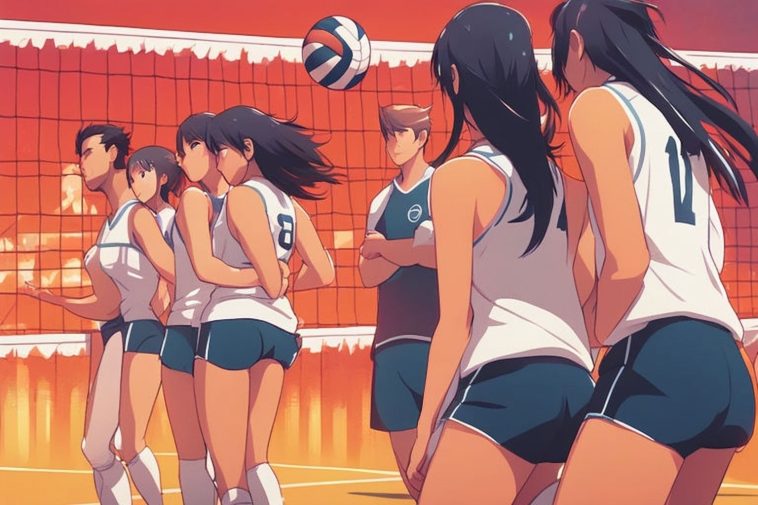jumphigherguide.com recommends Adam Folker's Vert Shock System to help you jump higher. Add 15 inches to your vertical jump now. Buy with confidence with their 90 day Money Back Guarantee!
-->Click Here<--

Vertical jump is a critical skill in volleyball, as it allows players to reach higher and perform more effective attacks, blocks, and serves. A strong vertical jump can give players a significant advantage in various aspects of the game, such as spiking, blocking, and serving. It can also improve their overall court presence and ability to compete at a high level. Volleyball is a sport that requires explosive power and the ability to elevate above the net, and a player’s vertical jump is a key factor in determining their success on the court.
The ability to jump higher than an opponent can provide a significant advantage in volleyball. Players with a higher vertical jump can more effectively spike the ball, block their opponent’s attacks, and serve the ball with greater power and accuracy. This can lead to more points scored, fewer points conceded, and an overall improvement in a team’s performance. Additionally, a strong vertical jump can enhance a player’s court presence, making them a more formidable and intimidating presence on the court.
Volleyball is a sport that requires a combination of physical attributes, including speed, agility, and strength. However, the vertical jump is often considered one of the most important skills for a volleyball player to possess. A player’s vertical jump can determine their ability to reach the ball at its highest point, which is crucial for effective spiking and blocking. Furthermore, a higher vertical jump can also improve a player’s serving ability, as they can generate more power and spin on the ball, making it more difficult for the opposing team to receive.
Good Vertical Jump For Volleyball – Key Takeaways
- A good vertical jump is crucial for success in volleyball, as it allows players to spike, block, and defend effectively.
- The vertical jump measurement is the height a player can reach from a standing position, and it is an important indicator of athletic ability in volleyball.
- Factors such as strength, power, flexibility, and technique all play a role in determining a player’s vertical jump performance.
- The average vertical jump height for volleyball players varies depending on the level of play, with elite players typically having higher jumps.
- Developing a powerful vertical jump requires a combination of strength training, plyometrics, and proper technique to maximize explosive power.
Understanding the Vertical Jump Measurement
The vertical jump is typically measured as the distance between a player’s standing reach and their maximum jump height. This measurement provides a clear and objective way to assess a player’s explosive power and overall athletic ability. Various methods, such as the Vertec or force plate testing, are used to accurately measure a player’s vertical jump.
The Vertec is a commonly used device for measuring vertical jump height. It consists of a series of vanes or tabs that are spaced evenly apart, typically in increments of one inch. The player stands underneath the Vertec and reaches up to touch the highest vane they can reach while standing. This measurement is recorded as the player’s standing reach. The player then performs a maximal vertical jump, attempting to touch the highest vane possible. The difference between the player’s standing reach and their maximum jump height is then calculated as their vertical jump measurement.
Force plate testing is another method used to measure vertical jump performance. This technique involves the player standing on a force plate, which is a specialized platform that measures the forces exerted by the player during a jump. The force plate can provide detailed information about the player’s power output, rate of force development, and other biomechanical factors that contribute to their vertical jump ability. This data can be used to identify areas for improvement and develop targeted training programs to enhance the player’s vertical jump performance.
Regardless of the specific method used, accurate vertical jump measurements provide valuable insights into a player’s explosive power and overall athletic ability. These measurements can be used to track a player’s progress over time, identify areas for improvement, and compare their performance to that of their peers or elite-level players. By understanding the vertical jump measurement and the various testing methods available, volleyball players and coaches can better assess and develop this critical skill.

Factors Influencing Vertical Jump Performance
Vertical jump performance is influenced by a variety of factors, including genetics, muscle strength, power, and technique. Understanding these factors can help players and coaches develop targeted training programs to improve their vertical jump and overall volleyball performance.
Genetics play a significant role in a player’s vertical jump ability. Factors such as muscle fiber type, bone structure, and neuromuscular coordination can all contribute to an individual’s natural jumping ability. While genetics cannot be changed, players can still work to maximize their potential through targeted training and development.
Muscle strength is another crucial factor in vertical jump performance. Players with greater lower-body strength, particularly in the quadriceps, hamstrings, and glutes, tend to have higher vertical jumps. Incorporating strength training exercises, such as squats, deadlifts, and lunges, can help players build the necessary muscle strength to improve their vertical jump.
Power, which is the combination of strength and speed, is also a key factor in vertical jump performance. Players who can generate high levels of power through explosive movements, such as plyometric exercises, tend to have higher vertical jumps. Developing power-based training programs can help players improve their ability to generate force and transfer it into a more powerful vertical jump.
Technique is another important factor that can influence vertical jump performance. Proper jumping mechanics, including the use of the arms, the timing of the takeoff, and the landing technique, can all contribute to a player’s vertical jump height. Coaches and players should focus on refining their jumping technique through drills and feedback to optimize their vertical jump performance.
By understanding the various factors that influence vertical jump performance, players and coaches can develop more effective training programs to improve this critical skill. By addressing these factors, players can unlock their full potential and achieve greater success on the volleyball court.
Average Vertical Jump Heights for Volleyball Players
The average vertical jump height for male volleyball players can range from 24 to 36 inches, while female players typically have a range of 18 to 30 inches. However, these values can vary depending on the player’s position, level of play, and overall athletic ability. Elite-level players often have vertical jumps that exceed these averages.
The position a player occupies on the volleyball court can also influence their average vertical jump height. For example, middle blockers and outside hitters, who are responsible for the majority of the team’s attacks and blocks, tend to have higher vertical jumps compared to setters or liberos. This is because their roles require them to generate more power and reach higher above the net.
The level of play can also impact the average vertical jump height of volleyball players. As players progress to higher levels of competition, such as collegiate or professional leagues, the average vertical jump height tends to increase. This is due to the more rigorous training programs, better access to resources, and the overall higher level of athleticism required at these levels.
It’s important to note that these are just general averages, and individual players may have vertical jumps that fall outside of these ranges. Factors such as genetics, training history, and overall athletic ability can all contribute to a player’s unique vertical jump performance. Coaches and players should focus on individual development and not solely rely on these averages when assessing a player’s potential or setting goals for improvement.
By understanding the typical vertical jump heights for volleyball players, both players and coaches can better evaluate their own performance and set realistic goals for improvement. This knowledge can also help inform the development of training programs and the selection of players for specific positions or roles on the team.
jumphigherguide.com recommends Adam Folker's Vert Shock System to help you jump higher. Add 15 inches to your vertical jump now. Buy with confidence with their 90 day Money Back Guarantee!
-->Click Here<--

Developing a Powerful Vertical Jump
| Vertical Jump | Rating |
|---|---|
| Less than 20 inches | Below average |
| 20-24 inches | Average |
| 25-29 inches | Good |
| 30-34 inches | Very good |
| 35+ inches | Excellent |
Developing a powerful vertical jump requires a combination of strength training, plyometric exercises, and technique-focused drills. Consistency and progressive overload in training are key to seeing long-term improvements in vertical jump performance.
Incorporating strength training exercises, such as squats, deadlifts, and lunges, can help players build the necessary muscle strength to generate more force during a vertical jump. These exercises target the major muscle groups involved in the jumping motion, including the quadriceps, hamstrings, and glutes. By gradually increasing the weight, volume, and intensity of these exercises, players can progressively overload their muscles and improve their overall strength.
Plyometric exercises, such as box jumps, depth jumps, and hurdle hops, are also crucial for developing a powerful vertical jump. These exercises focus on the stretch-shortening cycle, which is the rapid transition from eccentric (lengthening) to concentric (shortening) muscle contractions. This process allows players to generate more force and power during the jumping motion. Incorporating plyometric exercises into a training program, with proper progression and recovery, can lead to significant improvements in vertical jump height.
In addition to strength and plyometric training, players should also focus on refining their jumping technique. This includes proper body positioning, arm swing mechanics, and landing mechanics. Coaches can provide feedback and cues to help players optimize their jumping form, which can lead to more efficient and powerful vertical jumps.
Consistency is key when it comes to developing a powerful vertical jump. Players should aim to incorporate vertical jump training into their regular workout routines, gradually increasing the intensity and volume over time. This consistent approach, combined with proper recovery and nutrition, can lead to long-term improvements in vertical jump performance.
By following a well-designed training program that combines strength training, plyometric exercises, and technique-focused drills, volleyball players can unlock their full potential and develop a more powerful vertical jump. This, in turn, can translate to greater success on the volleyball court.
Training Techniques to Improve Vertical Jump
Exercises such as squats, deadlifts, box jumps, and depth jumps can be effective in building the necessary strength and power for a higher vertical jump. Incorporating these exercises into a well-rounded training program, along with proper recovery and nutrition, can lead to significant improvements in vertical jump height.
Squats are a fundamental exercise for developing lower-body strength and power. They target the quadriceps, hamstrings, and glutes, which are crucial muscle groups for vertical jump performance. By progressively increasing the weight and depth of the squat, players can build the strength and explosiveness needed for a higher vertical jump.
Deadlifts are another compound exercise that can significantly improve vertical jump performance. Deadlifts target the posterior chain, including the hamstrings and glutes, which are essential for generating force during the jumping motion. Proper form and progressive overload are crucial when incorporating deadlifts into a training program.
Box jumps and depth jumps are plyometric exercises that focus on the stretch-shortening cycle. These exercises involve jumping onto or off of a box, which challenges the player’s ability to generate power and transfer it into a vertical jump. Proper technique and progressive loading are essential to avoid injury and maximize the benefits of these exercises.
In addition to these specific exercises, a well-rounded training program should also include core stability exercises, balance training, and mobility work. These complementary components can help players improve their overall athletic performance and reduce the risk of injury, which is crucial for maintaining consistent vertical jump training.
It’s important to note that the implementation of these training techniques should be tailored to the individual player’s needs, abilities, and training history. Coaches and players should work together to develop a comprehensive training program that addresses the specific areas of improvement and gradually progresses in difficulty over time.
By incorporating these effective training techniques into their routine, volleyball players can build the necessary strength, power, and technique to significantly improve their vertical jump performance. This, in turn, can lead to greater success on the volleyball court.
Monitoring and Tracking Vertical Jump Progress
Regular testing and monitoring of vertical jump performance can help players and coaches track progress and make adjustments to their training programs. Keeping detailed records of vertical jump measurements over time can provide valuable insights into a player’s development and help identify areas for improvement.
Conducting periodic vertical jump assessments, such as the Vertec or force plate testing, allows players and coaches to measure and track changes in jump height over time. This data can be used to evaluate the effectiveness of the training program, identify areas of strength and weakness, and set realistic goals for improvement.
By maintaining detailed records of vertical jump measurements, players and coaches can analyze trends and patterns in a player’s performance. This information can be used to make informed decisions about adjusting the training program, modifying exercise selection, or addressing specific areas of concern.
Comparing a player’s vertical jump measurements to their peers or to elite-level players can also provide valuable context and motivation for improvement. This benchmarking can help players understand where they stand in relation to their competition and set ambitious yet achievable goals for their vertical jump development.
In addition to tracking vertical jump height, coaches and players may also want to monitor other performance metrics, such as power output, rate of force development, and landing mechanics. This comprehensive data can provide a more holistic understanding of a player’s vertical jump capabilities and guide the development of targeted training strategies.
By consistently monitoring and tracking vertical jump progress, players and coaches can make data-driven decisions to optimize their training programs and maximize the player’s potential. This approach can lead to significant improvements in vertical jump performance and ultimately contribute to greater success on the volleyball court.
Incorporating Vertical Jump Training into Volleyball Practice
Integrating vertical jump training into volleyball-specific drills and practice sessions can help players transfer their gains in the weight room to the court. Coaches should find ways to seamlessly incorporate vertical jump exercises and drills into their overall volleyball training program to maximize the benefits for their players.
One effective approach is to incorporate plyometric exercises, such as box jumps or depth jumps, directly into volleyball-specific drills. For example, players can perform a box jump before transitioning into a spike or block. This allows them to apply the power and explosiveness developed through plyometric training directly to volleyball-specific movements.
Another strategy is to incorporate vertical jump-focused drills into the warm-up or cool-down portions of practice. These drills can include exercises like standing vertical jumps, countermovement jumps, or jump rope variations. By integrating these drills throughout the practice session, players can maintain a focus on vertical jump development while also engaging in volleyball-specific activities.
Coaches can also design volleyball drills that challenge players to jump as high as possible, such as reaching for a raised target or competing in vertical jump challenges. These drills not only improve vertical jump performance but also reinforce the importance of this skill in the context of the game.
Furthermore, coaches can provide feedback and cues to players during volleyball-specific drills to help them optimize their jumping technique. This can include reminders about arm swing mechanics, body positioning, and landing mechanics, all of which can contribute to a more efficient and powerful vertical jump.
By seamlessly integrating vertical jump training into the overall volleyball practice structure, players can develop a stronger connection between their physical abilities and their on-court performance. This holistic approach can lead to greater improvements in vertical jump height and, ultimately, better overall volleyball performance.
Maximizing Your Vertical Jump for Volleyball Success
Achieving a high vertical jump can provide a significant advantage in volleyball, allowing players to excel in various aspects of the game. By understanding the importance of vertical jump, implementing effective training techniques, and consistently monitoring progress, volleyball players can unlock their full potential and achieve greater success on the court.
The vertical jump is a critical skill in volleyball, as it enables players to reach higher, spike the ball more effectively, and block their opponents’ attacks with greater success. A strong vertical jump can also enhance a player’s court presence and overall competitiveness, making them a more formidable and intimidating presence on the court.
To maximize their vertical jump for volleyball success, players should incorporate a comprehensive training program that focuses on developing strength, power, and technique. This includes incorporating exercises like squats, deadlifts, box jumps, and depth jumps, as well as plyometric drills and technique-focused training. Consistent practice, progressive overload, and proper recovery and nutrition are key to seeing long-term improvements in vertical jump performance.
Additionally, players and coaches should regularly monitor and track vertical jump progress, using tools like the Vertec or force plate testing. This data can provide valuable insights into a player’s development, identify areas for improvement, and help set realistic goals for continued growth.
By seamlessly integrating vertical jump training into their overall volleyball practice and training regimen, players can ensure that their physical abilities directly translate to on-court performance. This holistic approach can lead to significant improvements in vertical jump height and, ultimately, greater success in the sport of volleyball.
Maximizing one’s vertical jump is a crucial aspect of achieving excellence in volleyball. By understanding the importance of this skill, implementing effective training techniques, and consistently monitoring progress, volleyball players can unlock their full potential and become dominant forces on the court. With dedication, hard work, and a commitment to continuous improvement, players can harness the power of the vertical jump to achieve their volleyball aspirations.
Good Vertical Jump For Volleyball – FAQs
What is a good vertical jump for volleyball?
A good vertical jump for volleyball is typically around 24-28 inches for female players and 28-32 inches for male players.
Why is a good vertical jump important in volleyball?
A good vertical jump is important in volleyball as it allows players to reach higher to block or spike the ball, and to jump higher to serve or receive the ball.
How can I improve my vertical jump for volleyball?
To improve your vertical jump for volleyball, you can incorporate strength training exercises such as squats, lunges, and calf raises, as well as plyometric exercises like box jumps and jump squats into your workout routine.
Are there any specific drills to improve vertical jump for volleyball?
Yes, specific drills to improve vertical jump for volleyball include approach jumps, block jumps, and spike jumps. These drills focus on explosive power and jumping technique.
What are the benefits of having a good vertical jump in volleyball?
Having a good vertical jump in volleyball can help players to be more effective at blocking, spiking, serving, and receiving the ball. It can also give players a competitive edge over opponents.
jumphigherguide.com recommends Adam Folker's Vert Shock System to help you jump higher. Add 15 inches to your vertical jump now. Buy with confidence with their 90 day Money Back Guarantee!
-->Click Here<--



